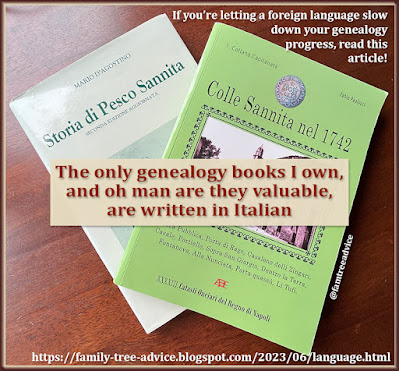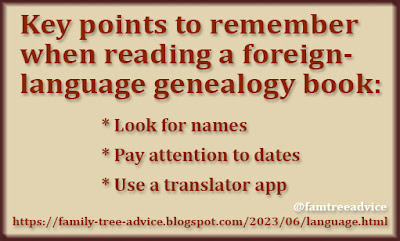Last week I mentioned that I own the definitive book on the history of one of my ancestral hometowns. It's called "Storia di Pesco Sannita," by Mario D'Agostino, and of course it's written in Italian.
I have plans to translate parts of it using the Google Translate app on my phone, but it's a lot of pages. So first, I'll pick out facts that add interesting details about the lives of some people in my family tree. UPDATE! By far the better option for instantly transcribing text from an image is Handwriting OCR. Use that, then paste the results into Google Translate.
I often see people saying they can't make any use of documents or books in another language. If I could, I'd grab every one of those people by the shoulders and shake them really hard.
You don't have to read or translate every single word to get meaning out of foreign text. All you have to do is:
- Look for names. The language doesn't matter if you know some of the names you're looking for.
- Pay attention to dates. If they aren't written in numerals, like 1852, they'll be in longhand. The FamilySearch Research Wiki has all kinds of help for this. Go to their website, choose your country of interest, and look for the Genealogical Word List. You'll find numbers, months, and common words on vital records.
- Use a translator app for context. If you're translating a neatly printed text, like in book, get the Google Translate app for your phone. You can select the camera within the app, point it at a page, and you'll see it change to English. Pretty amazing.
 |
| If the one and only book about your ancestral hometown is in another language, there's so much you can learn from it! |
Here's a sample of the details I'm finding in my Pesco Sannita book that aren't in the vital records:
- The town had 461 inhabitants in 1697, rising steadily to 2,460 inhabitants in 1857. (There were only 1,925 in 2020.)
- Lorenzo Maria Pennucci, born in 1763, was the town mayor in 1811. I confirmed this by opening a few 1811 birth records to see his signature at the bottom. It isn't something I would have noticed otherwise.
- Town doctor Paolo Emilio Pennucci, 1800–1846, was too sick to help his patients during an 1846 epidemic of typhus. He likely died of the disease himself.
- The town made Benito Mussolini an honorary citizen in 1924. Uh oh.
 |
| You can harvest the goods from a foreign-language book. |
I discovered these tidbits by:
- skimming the text for names
- locating the person in my family tree, and
- using the translation app for context.
Before this book, I bought another Italian language book about the town of Colle Sannita. My friend, Doctor Fabio Paolucci, compiled this book from the 1742 tax census of the town. It lists more than 560 households with names, ages, and relationships.
You'd better believe I wasn't going to let language slow me down. I knew I had some very early ancestors waiting for me in those pages. All I had to translate (until I memorized them) were the words for each household's belongs: sheep, oxen, pigs, mules, vineyards, vegetable gardens, houses, etc.
 |
| With so much technology at your fingertips, how can you pass up a foreign-language book about your ancestors? |
If you have the chance to get your hands on a book about your ancestral hometown, take the book! You can pull facts out of it pretty easily. And there will be goodies in there you can't get anywhere else.
And speaking of reading foreign languages:
Thank you. This is wonderful information.
ReplyDelete